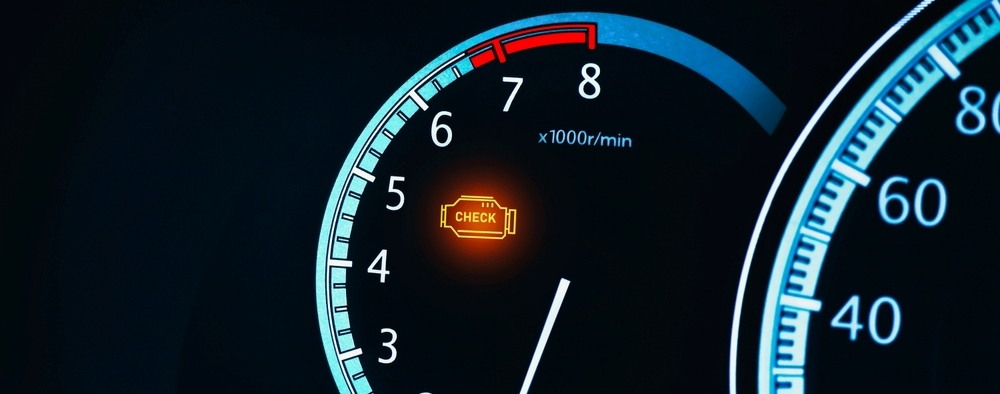
30 Apr Check Engine Light: Diagnosing The 10 Most Common Reasons
 Nothing can spark panic like seeing a check engine light illuminating your car’s dashboard. Is it still safe to drive? Should I pull over and call a tow truck? How much money is this problem going to cost me? Like I said, pure panic. Take a second to breathe. Some check engine light issues are minor, but a few of them require immediate service. Auto manufacturers design warning lights to assist drivers, so let’s review how they work. Hopefully, after reading the information below, you can determine if your car’s check engine light is warning you about a faulty gas cap, bad oxygen sensor, or dirty spark plug.
Nothing can spark panic like seeing a check engine light illuminating your car’s dashboard. Is it still safe to drive? Should I pull over and call a tow truck? How much money is this problem going to cost me? Like I said, pure panic. Take a second to breathe. Some check engine light issues are minor, but a few of them require immediate service. Auto manufacturers design warning lights to assist drivers, so let’s review how they work. Hopefully, after reading the information below, you can determine if your car’s check engine light is warning you about a faulty gas cap, bad oxygen sensor, or dirty spark plug.
What Is The Check Engine Light?
The check engine light is basically an early warning system for your car. Most vehicles manufactured after 1994 have an internal Onboard Diagnostic (OBD or OBD-II) computer. It monitors vehicle performance and generates trouble codes when there is a problem. This computer uses a microprocessor to read inputs from numerous system sensors in real time.
These readings calculate how the various electronically controlled systems react to actual driving situations. When operating correctly, these systems create efficient and safe operational conditions. When readings fall outside pre-determined safety ranges, the onboard computer illuminates a dashboard warning light and produces an error code.
How Do I Read Check Engine Light Error Codes?
You need a scanner or code reader to access the dashboard warning light codes, which you can purchase one at your local auto parts retailer or online. You can also schedule a diagnostic service at your trusted auto service center. The OBD port accesses the OBD-II system via an electrical plug that scanners, code readers, and other devices plug into. It is also used for other reasons, like software updates and state vehicle inspections. You can find the OBD port in one of several different locations:
-
- Under the steering column
- Near the center of the dashboard
- In the center console
- Under the glove box
Read your owner’s manual if you have trouble finding it.
10 Reasons For The Check Engine Light
The check engine light can look different depending on your vehicle’s year, make, and model. It may be orange, yellow, or red. It can look like an engine (with or without an exclamation point “!”), or contain words like “Check Engine,” “Service Engine Soon,” or something similar. A check engine light that remains lit requires a quick diagnosis to determine the issue. However, a flashing check engine light points to a more serious problem or damage that requires immediate intervention.
1. Loose Or Faulty Gas Cap
A loose or faulty gas cap can trigger a check engine light due to an emission control system leak. The fuel system operates under pressure, so the onboard computer reacts to a lack of pressure. To avoid triggering a false error, always turn off your car before refueling and ensure the gas cap is replaced securely before leaving the station.
2. Bad Oxygen Sensors (O2)
Oxygen sensors detect the amount of unburned oxygen in the exhaust when it leaves the engine. Based on the O2 sensor readings, the onboard computer adjusts the fuel injection to maintain the optimal air-to-fuel ratio. When oxygen sensors fail, you may notice a decrease in fuel economy due to an imbalanced ratio. Bad oxygen sensors affect performance and waste fuel. If left uncorrected, bad O2 sensors can damage the spark plugs and catalytic converter.
3. Dirty Mass-Air-Flow Sensor (MAF)
The mass airflow (MAF) sensor is part of the fuel injection system. This sensor measures the air temperature and density (or mass) going into the engine. It determines the correct air-to-fuel ratio required for optimal combustion and fuel efficiency.
4. Vacuum Leak
A vacuum leak occurs due to a cracked intake manifold or a faulty gasket. Vacuum leaks may produce whistling or hissing sounds from the engine, black exhaust smoke, and misfires.
5. Failing Catalytic Converter
The catalytic converter reduces dangerous emissions from the exhaust gas before it enters the atmosphere. A converter rarely fails without additional causes, so a full diagnostic inspection will help determine the underlying issues. If your vehicle has a failing catalytic converter, it won’t pass an emissions test and can let harmful fumes into your car. If you feel lightheaded or nauseous when driving, schedule a diagnostic inspection right away.
6. Broken Spark Plugs or Ignition Coils
Properly working spark plugs and ignition coils are required to ignite the air-to-fuel mixture in the cylinders. If they are broken, dirty, or inoperable, the engine may be sluggish and misfire, and your fuel economy can suffer. Many vehicles have specific replacement intervals for spark plugs, so be sure to follow the factory suggestions.
7. Car Battery or Alternator Issues
The engine uses the battery to start, and the alternator charges the car battery while idling and driving. If the voltage readings for either component drop, the check engine light (and maybe the battery light) will illuminate. Car batteries require replacement every 2-6 years, depending on your vehicle, battery type, and where you live. Most alternators have a lifespan of about 7-10 years or 150,000 miles.
8. Clogged Fuel Injectors
The fuel injectors shoot a fine mist of gasoline into the engine to produce combustion. Clogged or dirty injectors may produce too much or too little fuel for complete combustion. This creates an imbalance in the fuel system and possibly the exhaust system. Decreased fuel economy and dashboard warning lights will indicate your vehicle requires service to unclog your fuel injectors.
9. Faulty Powertrain Control Module (PCM)
The powertrain control module( PCM) runs your car’s powertrain, integrating the engine and transmission control modules. The PCM improves performance, fuel efficiency, and the emission system. A faulty PCM may trigger a Check Engine Light and create performance issues, reduced fuel efficiency, and increased emissions.
10. Loss Of Compression
Compression loss from a burned or bent valve, worn piston rings, or incorrect valve timing are serious issues that may trigger a Check Engine Light. Rough idle, misfires, and stalls are common symptoms of compression loss.
Diagnostic Service In Ann Arbor, MI
Knowing when to schedule professional help is essential in troubleshooting a check engine light. If the issue seems minor (like replacing a faulty gas cap) and you’re comfortable with basic maintenance tasks, go ahead and fix the problem. However, it’s best to consult a qualified auto technician for more complex repairs (like replacing oxygen sensors or spark plugs). Ron’s Garage can accurately diagnose, repair, and reset your vehicle’s check engine light. Our skilled technicians use sophisticated computer diagnostic equipment to determine the issue and get you back on the roads of Ann Arbor quickly.
Make A Check Engine Light Appointment
Call us at (734) 961-4701 or visit us online to make an appointment for a check engine light diagnostic service.

